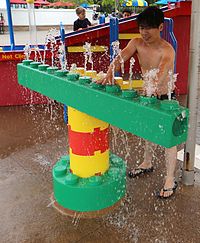The parks are marketed to families with younger children (11 and under), and although they have a number of roller coasters, they are not as numerous or as extreme as those in other parks, and there is a greater emphasis on rides suitable for younger children.
The parks are split into various areas, which are common between the parks. For example, all six of the parks include a Lego miniland, a model village which includes models of landmarks and scenes from around the world made from millions of genuine Lego bricks.
Educational elements[edit]
An important aspect of Legoland is education, epistemology, and learning.
Examples include:
- water flow channels in which participants can construct dams from Lego blocks to understand laminar and turbulent fluid flows;
- interactive musical instruments, such as musical fountains, and the Aquatune hydraulophone which is an underwater pipe organ in the shape of a giant lego block;
- a Lego Mindstorms centre (fun-based learning);
- Duplo Gardens (for smaller children), Driving area (including attractions such as Driving school, Boating school, Ballooning school, Flying school, and Fire Academy), My Town, Wild Woods, and Knight's Kingdom.
The parks' rides are all Lego themed; many are made to appear as if they are built out of Lego bricks. They tend to be based on one particular line of Lego: for example, a popular ride at all six parks is the Dragon Coaster, which is loosely based on theKnights' Kingdom Lego sets. Another popular ride is the Driving school, in which children can drive small electric cars made to look like Lego cars around a small road network, after which they gain a mock driving license. The exact set of rides varies between parks, although as with the Disney parks there is some overlap.


No comments:
Post a Comment